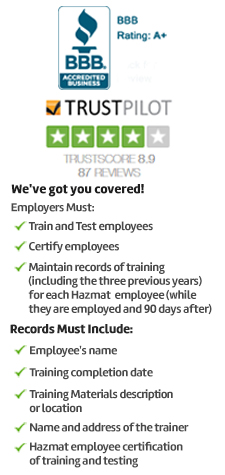
Cal/OSHA Training Certification

This course is in line with the State of California regulations made to safeguard workers associated with low-voltage and high-voltage electrical installations and equipment. Through this course, learners can understand the types and nature of electricity hazards and responsibilities of employers and employees towards making workplaces safe and healthy for all. We focus on the Cal/OSHA Electrical Safety Orders (ESOs) mentioned in Title 8 of the Code of California Regulations.
Governing regulations
As electricity hazards are common in all types of work environments, Cal/OSHA regulations covers all private sector employers and state and local government workplaces except federal government employees and offshore maritime workers. These workers, however, are protected under the federal OSHA regulations.
Companies and individual employee associated with electricity work environments must be aware of the electrical safety standards and regulations prescribed by the National Fire Protection Association (NFPA). The NFPA publication 70E, “Standard for Electrical Safety in the Workplace,” known as NFPA 70E, mentions safe work practices developed to prevent workers from electrical hazards exposure. This NFPA standard has guidance to identify risks and dangers, assess risks, select suitable protective equipment, and provide effective training to employees. NFPA 70E can be considered to be a useful resource for employers and employers to understand practices and procedures needed to enhance safety standards.
Course Overview
Electricity related accidents are common in every industry. Hence it is necessary to protect workers from various electricity hazards and risks. Electrical shock can cause immense harm to the body and can even lead to death. Electricity shock can happen when workers accidentally come in contact with live wire or faulty electricity circuits. Various countries have formed electrical safety regulations and work practices to reduce accidents, injuries and causalities. Through this course, we make the learners understand various regulations, safety standards and protective mechanisms with regard to electrical safety. Though our main focus is on California Regulations on electrical safety, students should also aware of other electricity safety regulations.
Who Must Take this Course?
As mentioned earlier, electricity hazards of various levels exist in all kinds of workplaces, workers can be subjected to electrical hazards if proper safety standards and regulations are not followed. Some of the hazards include sudden electrical shock, electrocution, burn injuries, fall from elevated places, injuries due to arc flash incidents, faulty installation, carelessness, lack of awareness, etc. In many cases, electrical hazards have resulted in permanent injury affecting the livelihood of workers. The Cal/OSHA Electrical Safety Orders require that California companies should become safety compliant so that employees can discharge their duties safely.
Course Format
Our Cal/OSHA Electrical Safety Hi/Lo Voltage Training course has been packaged with high-quality and easy to comprehend notes and course materials, explanations through graphical representations, audio presentations and a huge question bank for excellent preparation before the final exam.
Once completed, students or employees will be provided with the hardcopy of completion certificate and also a print copy of wallet card.
Continuing education credits?
Each student will receive 0.2 CEUs (or 2 CMEs) for completing this course.
Topics Covered
- About This Course
- Course Objectives
- Introduction to Electrical Safety Regulations
- Electrical Safety Regulations
- Cal/OSHA Safety Orders
- NFPA 70E
- Definitions of Key Terms
- The Importance of Electrical Safety
- Who Is At Risk for Electrical Accidents?
- General Employer Responsibilities
- Employee Responsibilities
- Electrical Hazards
- Effects of Electrical Current
- Electrical Shock Hazard
- Physical Reactions to Electrical Shock
- Fall Hazard
- Electrical Burn Hazard
- Arc Flash Hazard
- “People” Hazards
- Cal/OSHA Low-Voltage Electrical Safety Orders
- Low-Voltage Electrical Safety Orders (ESO-LV)
- Who May Perform Electrical Work
- Work on Energized Equipment or Systems
- Work on De-Energized Equipment or Systems
- Re-Energizing of Equipment or Systems
- Safety Precautions
- Electrical Installation Requirements
- Working Space
- Marking and Identification
- Grounding
- Cal/OSHA Low-Voltage Electrical Safety Orders
- Branch Circuits and Receptacles
- Outlet Devices
- Outdoor Wiring and Services
- Overcurrent Protection and Circuit Breakers
- General and Temporary Wiring
- Open Wiring
- Cabinets, Boxes, and Fittings
- Switches and Switchboards
- Flexible Cords and Cables
- Motors and Disconnections
- Hazardous Locations
- Specialized Regulations
- Cal/OSHA High-Voltage Electrical Safety Orders
- General Regulations
- Service and Service Entrance Equipment
- Feeders and Branch Circuits
- Wiring
- Pull Boxes
- Conduit
- Continuous Rigid Cable Supports
- Suspension of Cables
- Enclosures for Electrical Installations
- Conductors
- Other Elements of High-Voltage Installations
- Regulations for Special Situations and Locations
- Outdoor Wiring
- Working near Overhead Lines
- Work Around High-Voltage Lines
- Summary
- Additional Resources
- Exam

 NEBOSH CERTIFICATE
NEBOSH CERTIFICATE NEBOSH DIPLOMA
NEBOSH DIPLOMA IOSH
IOSH SAFETY DIPLOMA
SAFETY DIPLOMA CPD UK
CPD UK ROSPA UK
ROSPA UK FOOD SAFETY
FOOD SAFETY 



